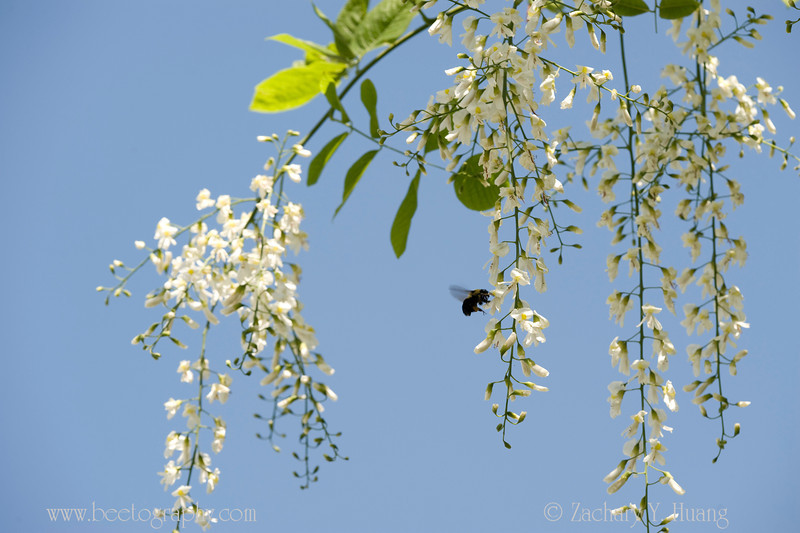I knew this one was a legume since during my first driving by, I thought it was a black locust. I had taken photos of bees on black locusts but that day, after the MBA board meeting, I suddenly wanted to take some more shots. Maybe that tree was just too pretty to pass. I thought it was close by, but could not find the tree after walking one whole mile with a 30 lb bag (I forgot to unload my laptop computer!). I stopped under a big horse chestnut tree (almost near Harrison!) with white flowers and was wondering why I would mistook that tree for a black locust. I walked back toward my packing lot and looked more closely on the right side… The tree was near MAC street and I missed it first time due to too many white tents there for the Art Festival. I stopped and took some shots. One large bee (I ought it was a carpenter bee at the time, but now I can see she has pollen baskets…I am pretty sure carpenters bees do not have pollen baskets) was foraging for pollen and nectar.
I emailed Dr. Frank Telewski (the Curator of the W.J. Beal Botanical Garden and Campus Arboretum and a Professor in Plant Biology) asking what it was since I knew it was not a black locust nor Sophora japonica (which has not bloomed yet). I was told it was Kentucky yellowwoods (Cladrastis kentukea, Fabaceae).
1. Beautiful white flowers, not as thick as black locust.

2. A single branch with flowers.

3. A bumble bee queen with pollen.

4. The same girl

5. Cropped vertically.

6. A few days back I saw a tree blooming in front of the IM West. I thought it was a Meliaceae, since the flowers were not typical at all for a legume! but honey bees were there. Dr. Telewski said it was Kentucky coffee tree (Gymnocladus dioicus. Fabaceae). Today (May 24th, 2012) I saw a male tree in the Beal Botanical Garden, almost ready to bloom. Pete who works at the garden says the tree is diecious, meaning they have male and female trees. I am assuming the ones I shot were females. So there you go! two trees blooming now with Kentucky in their names…both should have nectar and pollen for honey bees.

7. I had to use my 180 mm Macro to get larger bees.

8. Side view.

9.

10

11

12

Thought you might like to know that the City of Troy planted a yellowwood in the easment in front of my house three years ago as part of its program to replace the ash trees the City lost with native Michigan trees. Giving it plenty of TLC and its coming along great. GO GREEN!
Amazing shots – the close ups are simply stunning – especially love the 3rd last one.
Thanks for sharing!
Baggio.
Really gorgeous photos!! We have quite a few black locust trees on our farm and the bees love them, but I think we are too far north for honey locust. Your bee photos are spectacular.
Thank you for sharing some wonderful trees blooming in Kentucky. I wonder what got you into this kind of interest. It’s pretty unique yet can help the environment greatly.